
 Home
Page Back Ground History
Mining Regions
The Postcards
The Tokens
Links
Bibliography
Acknowledgements
Site
Forum Cards & Tokens Classified Ads.
Guest Book
Updates & News Contact
The Site
Home
Page Back Ground History
Mining Regions
The Postcards
The Tokens
Links
Bibliography
Acknowledgements
Site
Forum Cards & Tokens Classified Ads.
Guest Book
Updates & News Contact
The Site
 Home
Page Back Ground History
Mining Regions
The Postcards
The Tokens
Links
Bibliography
Acknowledgements
Site
Forum Cards & Tokens Classified Ads.
Guest Book
Updates & News Contact
The Site
Home
Page Back Ground History
Mining Regions
The Postcards
The Tokens
Links
Bibliography
Acknowledgements
Site
Forum Cards & Tokens Classified Ads.
Guest Book
Updates & News Contact
The Site

 The
Sperrgebiet
The
Sperrgebiet
Location: Lüderitz Province, Namibia formerly German South West Africa (View location on map)
Minerals Worked: Diamonds (alluvial)
Principal Mines: Various working zones along a restricted access costal stretch of 360 km long by 100 km wide. Principal mining sites at Lüderitz, Elizabeth Bay, Kolmanskop, Pomona, Bogenfels and Oranjemund.
Background History:
In
the 1860’s the British annexed Ichaboe and several other Islands off the south
coast of modern day Namibia. This followed the discovery and commercial exploitation of guano
deposits on the island several years earlier. In 1851, Cape Town based
adventurer/trader Aaron de Pass began working the guano deposits. Together he
and Captain John Spence, formed De Pass, Spence and Company which in September
1863 sign a deed of land sale with one of the local natives, Chief David
Christian. The agreement granted the company mining rights on the coastline from
Angra Pequena
(today’s town of Lüderitz) to Baker’s Cove, and inland to 15°50’ longitude, but excluded
both bays. On the strength of this De Pass formed the Pomona Mining Company and
tried unsuccessfully to mine copper, silver and lead from main land Pomona.
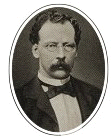 In 1882
the German
adventurer, Franz Adolf Eduard Lüderitz, decided to establish a costal base in
Namibia between the Orange River and Walvis Bay from where he hoped to prospect
for minerals further inland. Lüderitz’s mission received the blessing of the
German Government. Heinrich Vogelsang headed Lüderitz’s mission to South West
Africa.
In 1882
the German
adventurer, Franz Adolf Eduard Lüderitz, decided to establish a costal base in
Namibia between the Orange River and Walvis Bay from where he hoped to prospect
for minerals further inland. Lüderitz’s mission received the blessing of the
German Government. Heinrich Vogelsang headed Lüderitz’s mission to South West
Africa.
In April 1883
Vogelsang arrived at Angra Pequena and in May set off on foot to Bethanie to
meet the native chief, Josef Fredericks, and acquired the bay of Angra Pequena
plus five miles of ground in all directions around it. Payment was £100
and 200 guns. The German flag was raised for the first time at Angra
Pequena on 12 May 1883.
On
25 August 1883, Vogelsang extended Lüderitz’s business area by purchasing
from Josef Fredericks a 20 geographical-mile wide (a German geographical mile
being just over 7,420 m) coastal strip from the Orange River up to the 26°
latitude.
Historians
subsequently debated whether the signatories shared a common understanding of
the concept “geographical miles”. Did Josef Fredericks understand that
he was actually selling a strip of land which was approximately 148 km wide, and
not 20 miles (32 km) wide?
When
De Pass heard of the treaty, he protested to the British government, because he
had thought he purchased land in the same area in 1863. There was a flurry
of diplomatic activity between England and Germany. In 1884 Josef
Fredericks signed a declaration to the effect that the land was never actually
sold to the Cape Town company and so could be sold to Adolf Lüderitz. Two
Anglo-German commissions were appointed to investigate De Pass’ claims and it
seemed as if a compromise was reached in 1887 in which Lüderitz retained his
coastal strip with the exception of the Pomona mine and a radius of land 2 miles
around it which were to be retained by De Pass. In fact, such was the
controversy surrounding the Pomona land claim that once diamonds were found in
the region formal extraction of its fabulously rich local diamond deposits only
began in August 1912.
Lüderitz
himself landed for the first time at Angra Pequena in
October 1883 and by 1884, he had signed, on behalf of Germany, a protection
treaty with Chief Fredericks.
One
paragraph of the protection treaty conferred on Lüderitz or any company he
established, the right to build roads, telegraphs and railway lines, and also to
mine. In 1885, Lüderitz sold his lands, including the mining rights, to
the DKG, the German Colonial Company for South West Africa.
In 1886, Lüderitz, partly financed by the DKG, outfitted an expedition to explore the Orange River area. He travelled overland from Angra Pequena to the Orange River, which he sailed down in a collapsible canvas boat as far as Arrisdrift. On his return voyage from Alexander Bay to Angra Pequena Lüderitz became lost at sea, his body never to be recovered. After his death the DKG renamed Angra Pequena as “Lüderitzbucht” (today's Lüderitz) in his honour.
In April 1908, August Stauch, the railway station master at Grasplatz registered a 6 month prospecting claim of 10 km wide along a 24 km stretch of the Lüderitzbucht-Keetmanshoop railway line. In May 1908, Zacharia Lewala, who had formerly worked as a coachman in Cape Town and/or on the Kimberley mines picked up a diamond on a stretch of the railway line on which he was working. He reported it to his supervisor and the news was conveyed to Stauch – Namibia’s Diamond Rush was about to begin.
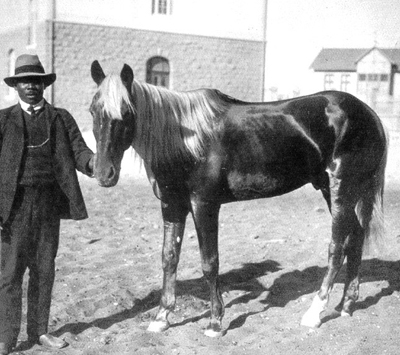
Zacharia Lewala (c.1908)
Between June and December of
1908 at least 40,000 carats of
diamonds were retrieved from the Lüderitz Bay District. Adolf Lüderitz’s dreams had become reality and
by 1913 in the order of, 20% of the world’s total output of diamonds came from the area extending from
Hottentott’s Bay to 25 km south of Bogenfels. Soon a large number of
companies had been founded and had acquired mining rights in the area.
Conditions
on the diamond fields were chaotic and the German Government was concerned about
a number of disputes regarding overlapping mining rights, the security of the
diamonds and the prevention of illegal mining. It also wanted to ensure
that the German receiver of revenue would have a maximum take from the newly
discovered mineral wealth. Therefore on 22 September 1908, the Secretary
of State proclaimed the Sperrgebiet, or prohibited area, covering the land
between the Orange River in the south and latitude 26° in the north and
extending inland for 100 km from the Atlantic coast. The sole mining
rights in the area reverted back to the DKG. However, the DKG had no intention
of participating directly in mining and in March 1909, a subsiduary company, the
Deutsche Diamanten-Gesellschaft was founded. Together with the other
mining companies the Deutsche Diamanten-Gesellschaft recovered some 4.7 million
carats between 1908 and 1913.
The
diamond mining and recovery process started with the excavation of the diamond
bearing sands and gravel. The larger companies employed electric shovels,
especially for the deeper parts of the deposits. Next the excavated material was
screened with swinging sieves, or trommels to remove the finer size fractions.
The screened material was then hand-jigged. Processing and recovery rates
using these manual methods were low and therefore central plants with
mechanically operated concentrating devices were built.
In
1909, a 30 km long narrow-gauge railway line was built from Lüderitz into the
diamond fields to the south. Initially mules pulled the ore wagons. Parallel to
the railway, a water pipeline and a pump station were installed. In 1912,
a mechanised plant was commissioned, the railway was extended to 70 km and
locomotives were introduced. In the southern part of the licence at
Elizabeth Bay, ore was mined and transported by train for treatment to a plant
at Kolmanskop.
On New Year’s Eve 1908, Stauch and Proffessor Robert Scheibe from the Royal Academy of Berlin were on a joint diamond prospecting expedition in the Pomona area. While Stauch wandered off to establish their position relative to the coast, Scheibe started looking for signs of diamonds while one of the native worker who had accompanied them (known to history only as Jakob) went off to collect firewood. “Jakob!” shouted Stauch jokingly on his return, “don’t look for wood, look for diamonds!” Jakob knelt down and seconds later, cried out in excitement. There, lying on the ground, were diamonds in profusion. Jakob had found so many, he began stuffing them in his mouth as he had already filled his pockets! Half fearing that the diamonds would disappear, they returned to the finds spot of the diamonds the same night. Now they could see them glittering in the moonlight. Subsequent recovery methods used in this rich area were simple - gangs of workers crawled across the valley floor on their hands and knees. In the first twenty months, one million carats of diamonds were recovered from the area that later transpired to be within the De Pass mining concession. Stauch named this place ldatal (Ida's Valley) after his wife. Other valleys in this astounding area were pegged and given romantic names such as Maerchental (fairy-tale valley) and Hexenkessel (witches' kettle). All mining in these areas was stopped while the legalities of the conflicting claims were discussed. It was only in 1912 that all claimants agreed to form the Pomona Diamanten Gesellschaft, and mining operations began. By 1914 the company was averaging a production of 50,000 carats a month.
In October 1908 a prospector named George Klinghardt, while leading a camel expedition, found diamonds near Bogenfels, the gigantic rock arch that juts into the Atlantic Ocean approximately 100 km south of Pomona. The extent of the diamond field was growing further.
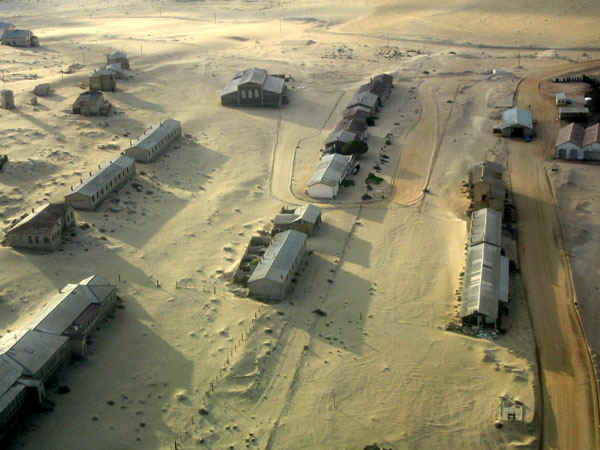
The deserted town of Kolmanskop today
Stauch set up his base at Kolmanskop approximately 10 km south west of Ludertizbucht. From modest beginnings of wooden buildings with corrugated iron roofs, Kolmanskop grew rapidly. In the middle of the desert, a town of handsome stone offices and homes in German architectural style emerged. The town had its own school, hospital, post office, police station, general dealer, bakery, butchery and soft-drink factory. Sea water piped from Elisabethbucht, on the coast, was desalinated to supplement fresh water brought in barrels from a borehole at Garub some 100 km away. A free block of ice was supplied daily to all households. For social life Kolmanskop had a clubhouse, called the Kasino, with a restaurant, bars, gambling saloons, a skittle alley and a hall for concerts, plays, balls and gymnastics.
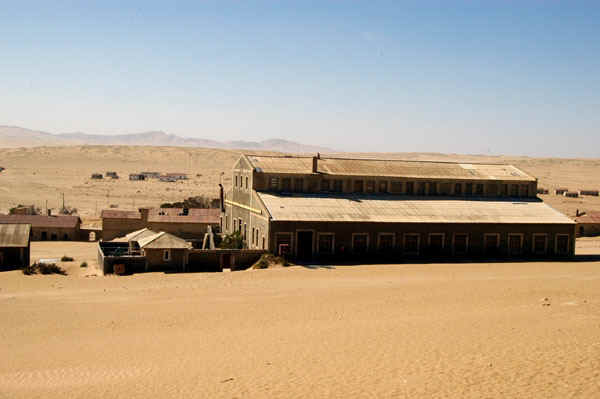
The Recreation Hall at Kolmanskop today
Stauch, a major
shareholder in the Pomona Diamanten Gesellschaft, went on to make a fortune and
to control millions, but in the 1930s the bubble burst, he went bankrupt and his
company was liquidated.
During 1912, the
DKG sent one of their geologist, Dr. Ernst Reuning, to the north bank of the
Orange River to prospect the coastal belt, and up the river as far as
Sendelingsdrif, but after some exploration there he returned empty-handed. In
October 1928, rich discoveries were made only a few hundred yards from the site
of one of Reuning’s digs. Reuning was the first to hypothesize that the
diamonds along the coast had been brought there from the African interior, along
the course of the Orange River.
The
discovery of diamonds rapidly accelerated Lüderitzbucht’s development in the
period 1908 to 1914. By 1910 the town had gain municipal status and by 1910 more
than 63 diamond companies were operating out it. The town’s infrastructure
rapidly grew and in June 1912 the town became linked to the outside world via
its own coastal radio station..
On
the night of 4 August 1914 Lüderitzbucht’s radio station received the news
that Britain and Germany were at war. On 7th August Britain conveyed to
South Africa that it would consider the occupation of the radio stations in
German South West Africa as a service to the Empire. The South African
Parliament authorised the campaign against its neighbour on September 12th.
A night attack on the small German garrison holding the police station at Raman’s Drift in mid September 1914, followed by a sea borne invasion of Lüderitzbucht four days later, formed the spearhead of the South African attack on the German Colony at the start of the Great War. German resistance to the South African invasion was short lived and by July 1915 a peace treaty had been signed which handed over administration of the former German colony to South Africa. The mandate of power over the region effectively remained in South African hands from that point up until 1989 when the fully independent state of Namibia was officially established.
During
the second half of 1919, Ernest Oppenheimer, Chairman of the South African Anglo
American Corporation, met with representatives of most of the larger German
diamond companies in Holland. One of the representatives was August Stauch.
With the financial backing of the Anglo American Corporation, Oppenheimer
acquired all the assets of ten most prominent German companies for the sum of £3,500,000.
With these he formed the Consolidated Diamond Mines of South West Africa (CDM)
on 9th February 1920.
Despite the
amalgamation of the more important diamond companies into one consolidated
company, accounting for royalties and taxation proved difficult. A
conference was held in 1921 between CDM, the Union Government and the
Administration of South West Africa to discuss the problem. Three
agreements were generated, one of which is known as the Halbscheid Agreement
which confirmed that the Administration of South West Africa was to hold the
exclusive prospecting and mining rights in the Sperrgebiet. It extended
this sole right for itself for a period ending not before 31 December 1970, and
prohibited all prospecting and mining for any minerals within the Sperrgebiet
for that period, except by CDM. Under this Agreement the boundaries of the
Sperrgebiet were proclaimed so that no uncertainties would exist as to what it
included or excluded.
Up until the
1920s diamond mining was concentrated in the central and northern part of the
Sperrgebiet coast, principally around Kolmanskop, Bogenfels, Pomona and Lüderitzbucht.
During this period the diamond industry enjoyed varying fortunes. In 1921,
many mines closed until finally, all diamond extraction was halted. However, one
year later, extraction re-commenced in Stauchslager, and at Zentralwäsche
(Central Washing area) and in October 1926 the application of modern machinery
enabled economic diamond extraction to commence at Elizabeth Bay.
In 1927 diamond
rich marine deposits were found at Alexander Bay followed a year later with
those on the north bank of the Orange River. In 1928, the largest rough
diamond ever to be found in South West Africa was discovered at Oranjemund. It
weighed 246½ carats. Mining of the estimated 100 km long diamond bearing
marine terrace began c.1930 on a small scale but was suspended between 1931 and
1935 during the depression
The 1929 Wall
Street crash and subsequent depression years affected the world’s diamond
industry. In 1931 De Beers Consolidated Diamond Mines Limited bought
Anglo-American's interest in CDM. In 1930, it reduced its weekly working shifts
and closed the operations at Zentralwäsche. In April 1931, the Elizabeth Bay
operation was closed, and in June 1932, CDM was forced to halt its production
completely. As the depression came to an end in 1935 CDM was able to commence
large scale mining operations at Oranjemund. Thus gradually the region’s
mining activities became focused on the marine terraces of the south with the
northern mining areas declining in importance.
Although
the township of Oranjemund was established in 1936, it was not until 1943 that
CDM moved its headquarters there from its previous location at Kolmanskop.
Mining
operations ceased in Kolmanskop in 1950, and the last person left six years
later. Kolmanskop slowly began its transformation into a ghost town that
is now slowly being reclaimed by the desert sands.
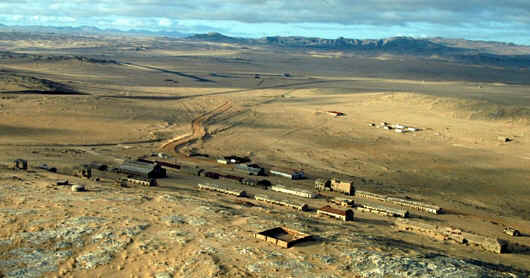
Kolmanskop today - A desert Ghost Town
Today diamond mining is still continued in parts of the Sperrgebiet especially around Oranjemund and the several off shore terraces. The whole region is still a restricted area with access in and out being strictly controlled. It is even forbidden to take out old mining equipment from the area in case it is used as smuggle out stolen diamonds.
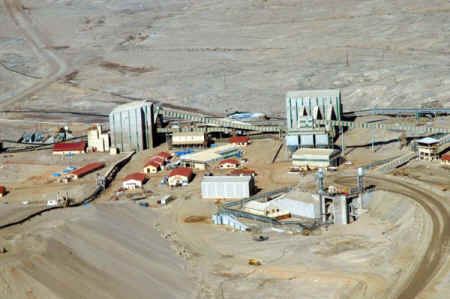
A modern Diamond Mine near Elizabeth Bay
The Tokens
The Postcards
The Postcard coverage of the diamond mining industry in this region commenced in the German Colonial period and continued well into the South African Mandate era. The postcards in this section have been sub-divided by location within the region as follows;